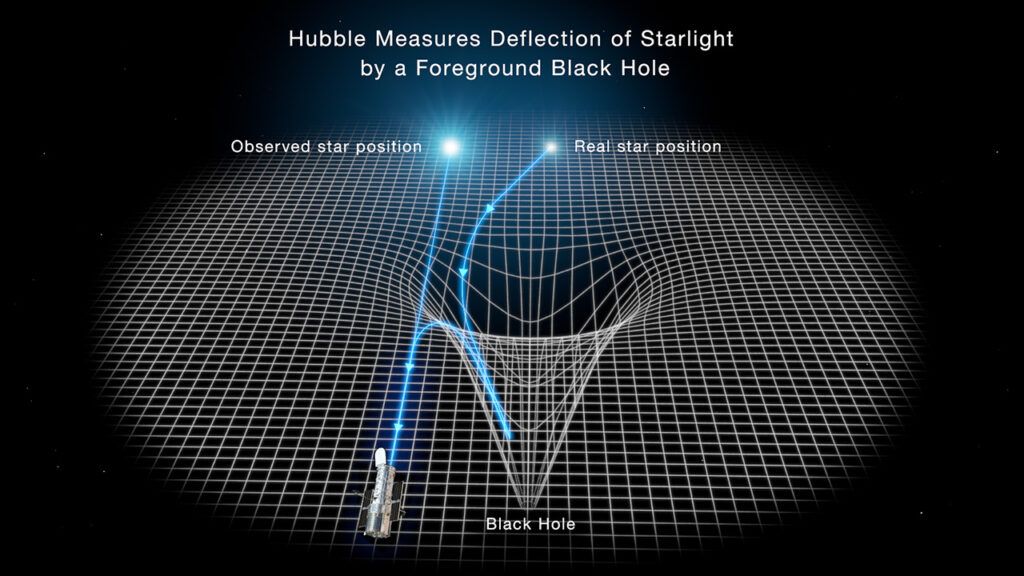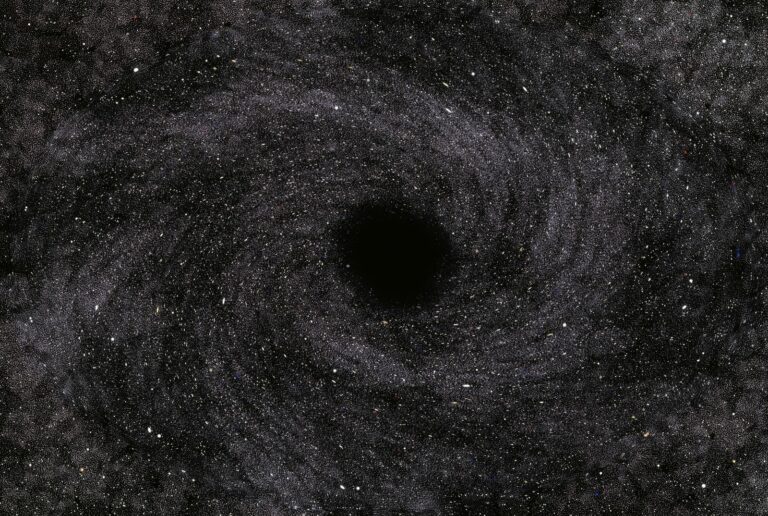Astronomers have potentially discovered a ‘dark’ free-floating black hole.
The formation of black holes from the demise of massive stars has been a subject of speculation among scientists. If this theory holds true, then it is expected that the Milky Way galaxy would be filled with a vast number of these mysterious entities. However, the challenge lies in detecting solitary black holes, as they remain hidden from direct observation.

In a recent groundbreaking discovery, a team of astronomers from the University of California, Berkeley, led by researchers, made a significant breakthrough. They have potentially identified a free-floating black hole for the very first time using a phenomenon called gravitational microlensing. This discovery occurred when the team observed a distant star brightening as its light was distorted by the immense gravitational field of an unseen object.
The research was spearheaded by Casey Lam, a graduate student, and Jessica Lu, an associate professor of astronomy at UC Berkeley. Their findings indicate that the mass of this invisible compact object falls within the range of 1.6 to 4.4 times that of the sun.
However, it is important to exercise caution as this object could also be a neutron star. Astronomers believe that remnants of dead stars with masses exceeding 2.2 solar masses can collapse into either black holes or neutron stars. Neutron stars, similar to black holes in terms of density and compactness, resist further collapse due to the internal pressure exerted by neutrons.
This finding signifies the initial occurrence of identifying an unattached black hole or neutron star through gravitational microlensing. By means of microlensing, we acquire knowledge about these solitary, condensed entities that cannot be observed through alternative methods.
Comprehending the frequency of these condensed entities in the Milky Way galaxy is crucial in unraveling the enigmas surrounding the evolution of stars, specifically the mechanisms of stellar demise, and illuminating the progression of our galaxy.
Furthermore, it might offer hints regarding the existence of primordial black holes, which are theorized to have formed abundantly during the early phases of the universe.
The study, spearheaded by Lam and Lu, in conjunction with their global partners, has been approved for print in The Astrophysical Journal Letters. Their examination encompasses various additional microlensing occurrences, yet they concluded that these were not triggered by black holes. Nevertheless, two of these incidents probably stemmed from either a white dwarf or a neutron star.
Furthermore, the group approximated the black hole population in the galaxy to be approximately 200 million, in close agreement with theoretical projections.
Same data, different conclusions
Interestingly, a separate research group from the Space Telescope Science Institute (STScI) in Baltimore carried out a parallel examination of the same microlensing incident. They contend that the mass of the compact object is around 7.1 solar masses, definitively confirming it as a black hole. Their discoveries will also be featured in The Astrophysical Journal.
Both teams made use of data from two microlensing surveys: the Optical Gravitational Lensing Experiment (OGLE) and the Microlensing Observations in Astrophysics (MOA), along with astrometric data from NASA’s Hubble Space Telescope. The object in question is known by the designations MOA-2011-BLG-191 and OGLE-2011-BLG-0462 (OB110462).
While microlensing surveys identify roughly 2,000 stars brightened by microlensing annually within the Milky Way, the inclusion of astrometric data allowed for the calculation of the compact object’s mass and distance from Earth. The team led by UC Berkeley estimated its distance to be between 2,280 and 6,260 light years, while the STScI team positioned it at approximately 5,153 light years away.
Looking for a needle in a haystack

Lu and Lam became interested in this particular object in 2020 when the STScI team raised questions about the possibility of certain microlensing events being caused by compact objects. Lu, who has been studying free-floating black holes since 2008, saw the potential of this data to improve estimates regarding the prevalence of these objects in the galaxy.
Lam’s analysis of the microlensing events uncovered that one event, known as OB110462, displayed characteristics that were consistent with those of a compact object. The prolonged period of increased brightness, lasting almost 300 days, was especially noteworthy. Lam’s previous research had suggested that long-duration events were more likely to involve black holes, indicating that such events could be a promising avenue for detecting these elusive objects.
Subsequent observations using the Hubble telescope confirmed the persistent gravitational influence of OB110462 on the light of the background star. Additional data, which is scheduled to be collected in 2022, is expected to shed further light on the true nature of this mysterious object.
The two research teams have arrived at contrasting conclusions due to disparities in their analysis of astrometric and photometric data. Lu and Lam’s team refrains from definitively classifying the object as a black hole, acknowledging the possibility of other explanations, such as a neutron star.
This difference highlights the importance of conducting thorough analysis and emphasizes the complexity involved in interpreting astrophysical data. Both teams are dedicated to improving their models and eagerly await further data to shed light on the true nature of this captivating cosmic phenomenon.
Do not forget to share your opinion with us to provide you with the best posts !




0 Comments